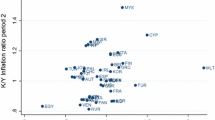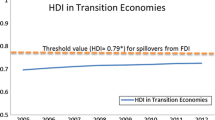Abstract
This paper examines changes in the labor productivity, efficiency, technology, and physical and human capital experienced by different regions in Italy between 1980 and 2006. Cobb-Douglas and translog production specifications are not supported by the data. Thus, non-parametric methods are used to compute the Malmquist indices and their components. Moreover, the bootstrap technique allows us to determine the confidence intervals of all components of the labor productivity decomposition. The results suggest that the contributions of efficiency, technology, and physical and human capital accumulation to labor productivity growth differ significantly between Southern Italy and the remainder of the country.






Similar content being viewed by others
Notes
The Malmquist productivity index is defined on a benchmark technology satisfying constant returns to scale (CRS). It provides an accurate measure of productivity change if, and only if, the index is defined on a technology exhibiting constant returns to scale (Färe et al. 1994).
The smooth bootstrap procedure for efficiency measures was implemented using FEAR package (Wilson 2008). The results are obtained from 5,000 bootstrap iterations.
Specifically, we test the Cobb-Douglas (translog) model against a fully nonparametric alternative. The null hypothesis of the test is that the parametric specification is correct and the alternative is a fully nonparametric model. We reject the parametric specifications at the 1 % level. Additional details and discussion are provided in “Appendix B” of Supplementary material.
Results are given in a separate “Appendix C” of Supplementary material.
Since the results on human capital accumulation may depend on the regional rates of return on schooling employed, the analysis is repeated using an unique parameter for all the regions estimated by Brunello and Miniaci (1999). These results, omitted for brevity, do not differ and are available from the authors upon request.
In the southern regions, the average years of schooling increase from 7.1 to 10.9 during the period 1980–2006, against the 7.5–11.1 registered at the national level.
These results are given in a separate “Appendix C” of Supplementary material.
To confirm this fact, we use the test for unimodality of Silverman (1981). We reject unimodality in 2006 at the 5 % level, while we cannot reject unimodality in 1980; the p values of the tests for 1980 and 2006 are 0.361 and 0.041, respectively.
We reject unimodality of the counterfactual distribution y E = EFF × y 1980 at the 5 % level, the p-values of the Silverman test is 0.017.
We do not reject unimodality introducing the other components separately, the p-values of the Silverman tests for y T = TECH × y 1980, y K = KACC × y 1980 and y H = HACC × y 1980 are 0.428, 0.674 and 0.407, respectively.
References
Badunenko O, Henderson DJ, Zelenyuk V (2008) Technological change and transition: relative contributions to worldwide growth during the 1990s. Oxf Bull Econ Stat 70(4):461–492
Basile R (2001) Export behaviour of italian manufacturing firms over the nineties: the role of innovation. Res Policy 30(8):1185–1201
Bronzini R, Piselli P (2009) Determinants of long-run regional productivity with geographical spillovers: the role of R&D, human capital and public infrastructure. Reg Sci Urban Econ 39(2):187–199
Brunello G, Miniaci R (1999) The economic returns to schooling for italian men. An evaluation based on instrumental variables. Labour Econ 6(4):509–519
Byrne JP, Fazio G, Piacentino D (2009) Total factor productivity convergence among Italian regions: some evidence from panel unit root tests. Reg Stud 43(1):63–76
Ceccobelli M, Gitto S, Mancuso P (2011) Ict e crescita: un’analisi dea per 14 paesi oecd. L’Industria 3:435–454
Ceccobelli M, Gitto S, Mancuso P (2012) Ict capital and labour productivity growth: a non-parametric analysis of 14 OECD countries. Telecommun Policy 36:282–292
Ciccone A (2004) Human capital as a factor of growth and employment at the regional level. The case of Italy. Mimeo
Conti M (2009) The Italian productivity decline: evidence from regional data. Giornale degli Economisti e Annali di Economia 68(3):269–309
Di Liberto A, Pigliaru F, Mura R (2008) How to measure the unobservable: a panel technique for the analysis of TFP convergence. Oxf Econ Pap 60:343–368
Färe R, Grosskopf S, Norris M, Zhang Z (1994) Productivity growth, technical progress, and efficiency change in industrialized countries. Am Econ Rev 84:66–83
Färe R, Grifell-Tatje E, Grosskopf S, Lovell C (1997) Biased technical change and the malmquist productivity index. Scand J Econ 99(1):119–127
Färe R, Grosskopf S, Margaritis D (2006) Productivity growth and convergence in the European union. J Prod Anal 25(1):111–141
Henderson DJ, Kumbhakar SC (2006) Public and private capital productivity puzzle: a nonparametric approach. South Econ J 73(1):219–232
Henderson DJ, Russell RR (2005) Human capital and convergence: a production-frontier approach. Int Econ Rev 46(4):1167–1205
Hsiao C, Li Q, Racine JS (2007) A consistent model specification test with mixed discrete and continuous data. J Econom 140(2):802–826
ISTAT (2006a) Conti Economici regionali anni 1980–2006
ISTAT (2006b) Rilevazione sulle forze di lavoro anni 1980–2006
Kneller R, Andrew Stevens P (2003) The specification of the aggregate production function in the presence of inefficiency. Econ Lett 81(2):223–226
Kumar S, Russell RR (2002) Technological change, technological catch-up, and capital deepening: relative contributions to growth and convergence. Am Econ Rev 92(3):527–548
Li Q, Maasoumi E, Racine JS (2009) A nonparametric test for equality of distributions with mixed categorical and continuous data. J Econ 148(2):186–200
Maffezzoli M (2006) Convergence across Italian regions and the role of technological catch-up. Topics Macroecon 6(1), article 15
Mastromarco C, Woitek U (2006) Public infrastructure investment and efficiency in italian regions. J Prod Anal 25:57–65
Montanaro P (2003) Lo stock di capitale pubblico: una stima per regione e per tipologia di bene. Rivista economica del Mezzogiorno, pp 423–462
Ortega-Argilés R, Piva M, Potters L, Vivarelli M (2010) Is corporate r&d investment in high-tech sectors more effective. Contemp Econ Policy 28(3):353–365
Paci R, Pusceddu N (2000) Una stima dello stock di capitale per le regioni italiane: 1970–1994. Rassegna Economica, Quaderni di Ricerca 4:97–118
Piacentino D, Vassallo E (2011) Exploring the sources of labour productivity growth and convergence in the italian regions: some evidence from a production frontier approach. Ann Reg Sci 46:469–486
Picci L (1999) Productivity and infrastructure in the Italian regions. Giornale degli Economisti e Annali di Economia 58:329–353
Quah DT (1997) Empirics for growth and distribution: stratification, polarization, and convergence clubs. J Econ Growth 2(1):27–59
Scoppa V (2007) Quality of human and physical capital and technological gaps across Italian regions. Reg Stud 41(5):585–599
Sheather SJ, Jones MC (1991) A reliable data-based bandwidth selection method for kernel density estimation. J R Stat Soc Ser B 53:683–690
Silverman BW (1981) Using kernel density estimates to investigate multimodality. J R Stat Soc Ser B 43(1):97–99
Simar L, Wilson PW (1998) Sensitivity analysis of efficiency scores: how to bootstrap in nonparametric frontier models. Manage Sci 44:49–61
Simar L, Wilson PW (1999) Estimating and bootstrapping Malmquist indices. Eur J Oper Res 115:459–471
Simar L, Wilson PW (2008) Statistical inference in nonparametric frontier models: recent developments and perspectives. In: Fried H, Lovell CAK, Schmidt S (eds) The measurement of productive efficiency, chap 4, 2nd edn. Oxford University Press, Oxford, pp 421–521
Wilson PW (2008) FEAR: A software package for frontier efficiency analysis with R. Socio-Econ Plan Sci 4:247–254
Zelenyuk V (2006) Aggregation of malmquist productivity indexes. Eur J Oper Res 174(2):1076–1086
Acknowledgments
We wish to thank three anonymous reviewers, an associate editor, Prof. Wilson, and Prof. Sickles for constructive comments. We also thank Pasqualino Montanaro and Vincenzo Scoppa for sharing their regional dataset. Any remaining errors are solely our responsibility.
Author information
Authors and Affiliations
Corresponding author
Electronic supplementary material
Below is the link to the electronic supplementary material.
Appendix A
Appendix A
Given the estimates \({\widehat{{\mathcal{M}}}(t_1,t_2)}\) of the unknown true values of \({{\mathcal{M}}(t_1,t_2)}\), we generate, through the DGP process, a series of pseudo-datasets to obtain a bootstrap estimate \({\widehat{{\mathcal{M}}}^*(t_1,t_2)}\). Simar and Wilson (1998) discussed the problems that arise for bootstrapping in DEA models, and they suggested the use of a smooth bootstrap procedure. In addition, the Malmquist index uses panel data, with the possibility of temporal correlation. For this reason, Simar and Wilson (1999) modified the bootstrap algorithm for efficiency scores to preserve any temporal correlation present in the data by applying a bivariate smoothing procedure. The procedure can be summarized as follows:
-
1.
Compute the Malmquist productivity index \({\widehat{{\mathcal{M}}}_i(t_1,t_2)}\), for each region \(i=1,\ldots,20\), by solving the DEA models and using Eq. (1), as described in Färe et al. (1994).
-
2.
Calculate the pseudo-dataset \(\left\{\left(\user2{X}^*_{it},Y^*_{it} \right);i=1,\ldots,20; t=1,2 \right\}\) to obtain the reference bootstrap technology using bivariate kernel density where the bandwidth was selected following the normal reference rule.
-
3.
Compute the bootstrap estimate of the Malmquist index \({\widehat{{\mathcal{M}}}^*_{i,b}(t_1,t_2)}\) for each region through the pseudo-sample obtained in step 2.
-
4.
Repeat steps 2 and 3, B times (number of bootstrap replications) to obtain the bootstrap sample \({\left\{\widehat{{\mathcal{M}}}^*_{i,1}(t_1,t_2),\ldots ,\widehat{{\mathcal{M}}}^*_{i,B}(t_1,t_2)\right\}}\).
-
5.
From the bootstrap sample, compute the confidence intervals for the Malmquist index by selecting the appropriate percentiles.
The construction of the confidence intervals is obtained by sorting the values \({\left\{\widehat{{\mathcal{M}}}^*_{i,b}(t_1,t_2)- \widehat{{\mathcal{M}}}_{i}(t_1,t_2)\right\}^{B}_{b=1}}\) in increasing order and deleting the \(\left(\frac{\alpha}{2}\cdot 100 \right)\)-percent of the elements at either end of the sorted list. Then, for setting \(-\widehat{a}^*_\alpha\) and \(-\widehat{b}^*_\alpha\) (with \(\widehat{a}^*_\alpha <\widehat{b}^*_\alpha\)), which is equal to the endpoints of the sorted array, the estimated (1 − α)-percent confidence interval for the productivity index is:
The relation (4) is similarly computed for the other components of the labor productivity decomposition: efficiency change (EFF), technological change (TECH), capital (KACC) and human capital accumulation (HACC).
Rights and permissions
About this article
Cite this article
Gitto, S., Mancuso, P. The contribution of physical and human capital accumulation to Italian regional growth: a nonparametric perspective. J Prod Anal 43, 1–12 (2015). https://doi.org/10.1007/s11123-013-0362-y
Published:
Issue Date:
DOI: https://doi.org/10.1007/s11123-013-0362-y
Keywords
- Total factor productivity (TFP)
- Regional convergence
- Human capital
- Bootstrap
- Data envelopment analysis (DEA)
- Italian regions




